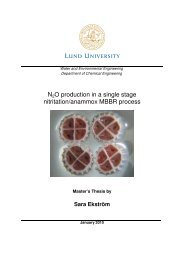Alexander Szabo and Oscar Engle - Svenskt Vatten
Alexander Szabo and Oscar Engle - Svenskt Vatten
Alexander Szabo and Oscar Engle - Svenskt Vatten
Create successful ePaper yourself
Turn your PDF publications into a flip-book with our unique Google optimized e-Paper software.
accuracy (the accuracy of a single analysis is low) of the COD <strong>and</strong> TSS levels upstream <strong>and</strong><br />
downstream of the pond, more sampling is needed. The COD <strong>and</strong> TSS levels may also fluctuate<br />
over the time, both upstream <strong>and</strong> downstream of the pond.<br />
Another aspect that must be considered is the accuracy of the COD-reagents. The accuracy <strong>and</strong><br />
precision with Hach’s COD tests are around 5-10% <strong>and</strong> can be even higher if the sample contains<br />
suspended solid (Boyles, 2007). It is possible that the sample analyzed from the stream contained<br />
suspended solids (particle size of 1-100 µm).<br />
<br />
<br />
<br />
<br />
7. Sampling <strong>and</strong> analysis methods <br />
Sampling <strong>and</strong> flow measurements<br />
The sampling procedure included filling plastic containers (each about 1 liter of volume) with<br />
sample water from the influent chamber <strong>and</strong> one container with water from the effluent channel.<br />
The samples were immediately transported to the laboratory where they were stored in a cooling<br />
room (temperature between 10-13 °C).The following day the analyses of BOD <strong>and</strong> COD was<br />
started. TSS analyses were usually carried out a few days after the sampling. The procedure for<br />
flow measurements is described in Chapter 8.<br />
COD<br />
COD analyses have been undertaken with Hach st<strong>and</strong>ard procedure for colorimetric<br />
determination. The Hach reagents used were capable of “high range” (0-1500 mg COD/l). The<br />
digestions of the reagents were done in a Hach DRB 200 for 2 hours at 150 °C (see Figure 7.1).<br />
The analysis has been done with single samples.<br />
The reading of the Hach COD reagents was done in a Hach DR/4000 <strong>and</strong> a Hach DR/5000 (see<br />
Figure 7.1). The average values from both machines were calculated.<br />
<br />
31















